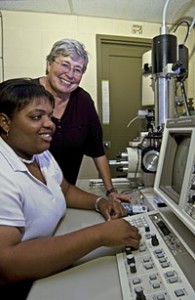
TUSCALOOSA, Ala. — The Howard Hughes Medical Institute will award $1.5 million to The University of Alabama to launch four distinct initiatives designed to teach and inspire the nation’s next-generation of scientists.
Students from UA, Stillman College and Shelton State Community College along with both area high school students and graduate students interested in becoming college professors stand to benefit from the implementation of the programs designed by University of Alabama faculty.
“This interdisciplinary, multi-campus project will enable The University of Alabama to increase the diversity of students attracted to careers in science and will enhance the success of these students in the sciences,” said Dr. Martha Powell, professor of biological sciences at UA.
UA’s proposal was one of 50 selected for funding from among the 165 research universities submitting proposals for the institute’s Precollege and Undergraduate Science Education Program, according to today’s announcement by the institute. The Howard Hughes Medical Institute, or HHMI, is awarding $70 million to research universities in 30 states and the District of Columbia through this program.
Powell, also an HHMI program director, said the 4-year grant is designed to help students see the excitement of scientific research early in their careers.
“The thing that is exciting about being a scientist is not, primarily, reading your freshman textbook – which weighs about a ton and contains a tremendous amount of information,” said Powell. “It’s about finding discovery. Young science scholars often know what the findings are, but they don’t know how the discoveries are made. We’re helping them experience this.”
The four initiatives include:
- The Hughes Undergraduate Researcher Program
Twenty-four undergraduate students from UA, Stillman College and Shelton State will take a class together during their freshman and sophomore years. Its location will rotate in a round-robin format among the three campuses enabling the students to experience the culture of each campus and increasing camaraderie, Powell said. Faculty research mentors from biology, chemistry and chemical and biological engineering will be paired with the students who will conduct research. The students will later have opportunity to present their work at national meetings and to write scholarly articles. Visiting scientists from a variety of backgrounds will meet with the students and participants will take field trips to laboratory and research facilities. Dr. Matthew Jenny, assistant professor of biological sciences at UA, is the director of the undergraduate program. Drs. Rosianna Gray and Sharon Rose are the program liaisons at Stillman College and Shelton State Community College, respectively.
- Future Faculty Program
Graduate teaching assistants with an interest in becoming professors will work alongside UA faculty, learning how to provide active learning experiences for students through the use of innovative techniques in group questioning and problem solving. Dr. Kim Caldwell, associate professor of biological sciences at UA, will be the lead faculty member in this effort. These graduate students will mentor the Hughes Undergraduate Researchers. A goal of the program, Powell says, is to enhance the diversity of future faculty by encouraging underrepresented minority graduate students to participate in the program.
- Redesign of Freshman Honors Chemistry Laboratory
In this component, UA will transform how it teaches freshman Honors Chemistry with more applications of technology, computations and active learning experiences. For example, some experiments that are foundational to understanding quantum chemistry are difficult to implement in a freshman lab. Through the use of simulations in a Virtual ChemLab, students can gain an appreciation for these experiments. Dr. David Dixon, Robert Ramsay Chair of Chemistry, will develop the course redesign.
- Development of Experimental Science Kits for High-Schoolers
Partnering with UA’s College of Education, its Alabama Science in Motion Program and researchers in UA’s Institute for Social Science Research, UA faculty from biological sciences, chemistry and nutrition will partner with high school teachers in Alabama to develop experiments designed to reinforce science concepts. The focus will be on concepts that Alabama High School Graduate Exam scores indicate are in need of strengthening. Health and nutritional issues that statistics indicate negatively impact many Alabamians will be a focus. Dr. Jill Shearin Driver, director of Alabama Science in Motion and In-Service Center, and Science in Motion’s Lorrie Robinson, biology specialist, and Beth Sherrill, chemistry specialist, will be among those involved.
Since 1998, Powell has been awarded $4.9 million from the Howard Hughes Medical Institute to strengthen undergraduate education in the sciences through three separate programs.
“The University of Alabama has been very supportive of these programs,” Powell said. “It has augmented the Howard Hughes Medical Institute funding enriching the impact of these programs and even bridging the funding during periods when it was not active.”
Contact
Chris Bryant, UA Media Relations, 205/348-8323, cbryant@ur.ua.edu
Source
Dr. Martha Powell, 205/348-9017, mpowell@biology.as.ua.edu